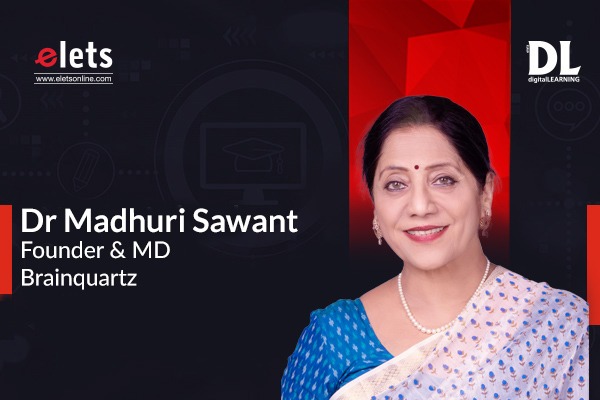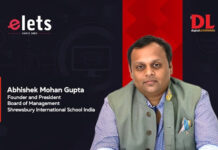
AI tools ultimately synthesize content in a much more focused manner than search engines, so one can think of them as “the next generation of search engines. Another aspect is that we will absolutely have to change our systems of evaluating talent. There may be a shift to more synchronous forms of learning or identifying deliberate flaws in AI reasoning, or more, shared Dr Madhuri Sawant, Founder & MD, Brainquartz in an exclusive conversation with Sheeba Chauhan of Elets News Network. Edited excerpts:
From the doors of IIT Bombay to building Brainquartz, your journey seems incredible. Let us know about your journey, success, and pitfalls in the path. Your vision behind starting Brainquartz.
Completing my PhD from IIT Bombay was an intense but incomparable experience, especially as a woman in the 1970s. Those five years taught me a lot of life skills including patience, acceptance of failure, and resilience. Thereafter, I continued teaching at IIT, and then in various university departments for some time before I joined the corporate sector.
Subsequently, I was involved in an ambitious Government of India’s Aakash Tablet project to distribute tablets to students for learning from rural areas. There were certainly challenges, but the results were astonishing to me in terms of the ease of uptake of technology by children and their selfmotivation. I then served as an education advisor to my home state of Maharashtra, where I conducted satellite internetbased teachers’ training for over 1000 teachers at a time in 10 remote, geographically dispersed districts – the first of its kind in India. This experience taught me how technology can be leveraged to drive better outcomes for teachers.
These experiences along with my deep, decades-long interest in learning and teaching drove me in starting Brainquartz. Our ethos is very simple: educated students are key to a successful future for India and the world, but we must have teachers who are capable of nurturing such students since they are the pillars of the education institution. This requires world-class teacher training, which is what Brainquartz provides.
How are you executing your mission of building a world-class learning experience? How technologies are leveraged to make this mission a great success?
Brainquartz’s mission is to provide the best training to teachers from the broadest set of backgrounds. This is not a trivial task. Many teachers are apprehensive about using technology. Some are apprehensive of new teaching techniques. Some are simply uncomfortable with change.
We recognise and address all of these concerns through the use of empathy, simplicity, and a gradual approach to the value of technology in helping them and their students. We provide example based learning that empowers them with subject knowledge and demonstrates the effective use of the right combination of approach and technology for each subject. We practice what we preach by using this combination to develop our own high-quality content which teachers and learners alike can use.
In terms of specific technologies, our content uses Q&A type videos which provoke reflection right in the moment. We also use animations to assist with visualizations of abstract concepts. And we use responsive design to make sure that our content can be viewed on any device at any time.
With the enlarged AI market and applications like ChatGPT, do you take this as a peril or promise for your target market?
A little bit of both. The peril is at two levels. The first is using tools like ChatGPT to generate answers to questions without having to put in the critical thinking that would otherwise have been required to generate those answers. This means that written answers can no longer serve as an effective proxy for understanding, which encourages cheating, etc. The second level is that with our current systems of learner evaluation, we run the risk of certifying entire generations of learners as qualified in skills that they clearly would not have, which is not desired.
But there is also promise. AI tools ultimately synthesize content in a much more focused manner than search engines, so one can think of them as “the next generation of search engines. Another aspect is that we will absolutely have to change our systems of evaluating talent. There may be a shift to more synchronous forms of learning, or identifying deliberate flaws in AI reasoning, or more. AI certainly isn’t perfect, and identifying flaws in its reasoning, or having it as a virtual “debate opponent”, could sharpen skills in ways that we haven’t had a chance to explore before.
World Education Summit 2023 in Dubai aims to unlock fresh strategies and foster new approaches to build a future-ready education ecosystem. How do you think such conferences help to uplift education standards at a global level?
I commend the work that the organizers of World Education Summit 2023 are doing. Conferences such as this facilitate these exchanges of ideas & best practices through both presentations (one-to-many) and networking (one-on-one).
Today we are at the intersection of multiple global megatrends: ubiquitous connectivity, high-value use cases such as digital payments, remote work/remote education, misinformation, and climate change. However, globally, there is no uniformity in education systems, every country follows its own style of school education system. Such platforms and conferences could bring uniformity and best practices and ideas which could be adapted globally to standardise school education system.
The exchange of ideas and best practices, ideally in an in person setting, helps educators, technologists, businesspeople, and policymakers from around the world drive higher standards in their respective spheres and as a result for the whole world.
Your aim is to make knowledge more accessible through simple methods of learning and making education more relevant to students. How is Brainquartz bringing accessibility while keeping a watch on quality education?
The Brainquartz philosophy stands on three pillars: (1) no compromises on the quality of content; (2) leveraging of technology to make this content more accessible; (3) relying on natural human curiosity to drive learning.
One of the most powerful aspects of technology is the ability to separate content creation and distribution. Previously, high-quality training used to require a high degree of in-person presence, but now we can create content ahead of time, have a lesser in-person presence to stimulate engagement, and continue engagement online after the fact. We have found this “online/ in-person/online” cycle to be very effective at driving high-value outcomes for teachers and students.
Our ongoing assessment of the students after completing every topic keeps the track of their understanding of the concepts in the classroom/ online teaching quantitatively. While the collaborative projects, story writing, storytelling, and lab experiments activities monitor students’ engagement in the subject, and respect for others’ ideas qualitatively






















